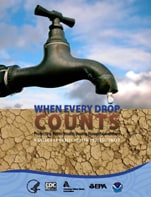When Every Drop Counts: Protecting Public Health During Drought Conditions—A Guide for Public Health Professionals
Drought is a natural phenomenon. During a drought, rainfall levels or other precipitation types are lower than average for an extended period, resulting in an inadequate water supply. Although the literature contains many well-researched articles on the aspects and implications of drought itself, the Centers for Disease Control and Prevention (CDC) recognizes much is yet to be learned about how drought affects public health in the United States. With regard to drought preparedness and response, public health experts at all levels operate today with only limited guidance. With regard to how water shortages affect public health at the community level, overall understanding is less than optimal.
In response, CDC’s National Center for Environmental Health (NCEH) developed When Every Drop Counts: Protecting Public Health During Drought Conditions—A Guide for Public Health Professionals. This publication is intended to assist public health officials, practitioners, and other stakeholders in their efforts first to understand and then to prepare for drought in their communities. It provides information about how drought affects public health, recommends steps to help mitigate the health effects of drought, identifies future needs for research and other drought related activities, and provides a list of helpful resources and tools.
To obtain a copy of or for more information about When Every Drop Counts: Protecting Public Health During Drought Conditions—A Guide for Public Health Professionals, please send an e-mail to drought@cdc.gov.
Download a PDF of the full document pdf icon[PDF – 5 MB].
